BEST Marinara Sauce
This post may contain affiliate links. See my disclosure policy.
Look no further for the BEST Marinara Sauce recipe EVER! You won’t find a more flavorful marinara sauce. It’s easy to make and is absolutely PACKED with flavor! Canning instructions are included so you can enjoy the fresh flavor of tomatoes all year long!

What is Marinara Sauce?
Marinara sauce is a popular tomato sauce that is an essential staple in Italian cuisine. It consists of tomatoes, garlic, onions, olive oil, and a variety of herbs and spices. It’s known for its bright and fresh flavor, is highly versatile, and is a key component in many Italian dishes such as chicken parmesan, eggplant parmesan, pasta alla norma, and spaghetti and meatballs.
Ingredients
It’s hard to beat a simple dish of fresh pasta topped with homemade marinara sauce. The key is using quality products and when you have those these simplest of dishes come to life. The Italians have relied on the best of the best tomatoes for centuries: Sun-kissed San Marzano tomatoes. They’re stronger in flavor and much sweeter than most any other variety. And for that reason it’s hard to replicate the flavor of the marinara sauces you find in southern Italy. Our tomatoes require the help of a few flavor boosts, a dash of sugar being one of them.
This marinara sauce is slow-simmered with a variety of herbs and seasonings for 2 hours. The end result is a delicious sauce you can either eat right away, freeze or can for long-term storage so you can enjoy the vibrancy of Summer all year long! This is the BEST marinara sauce for canning!
I am often asked if you can use fresh onions instead of dehydrated onions. I recommend dehydrated onions for two reasons 1) fresh onions are high in water and can dilute and interfere with the pH level of the tomato sauce (this is not important however if you are not canning the sauce and 2) dehydrated onions are especially suited to canning because their flavor is more concentrated and they contribute a better flavor long-term.
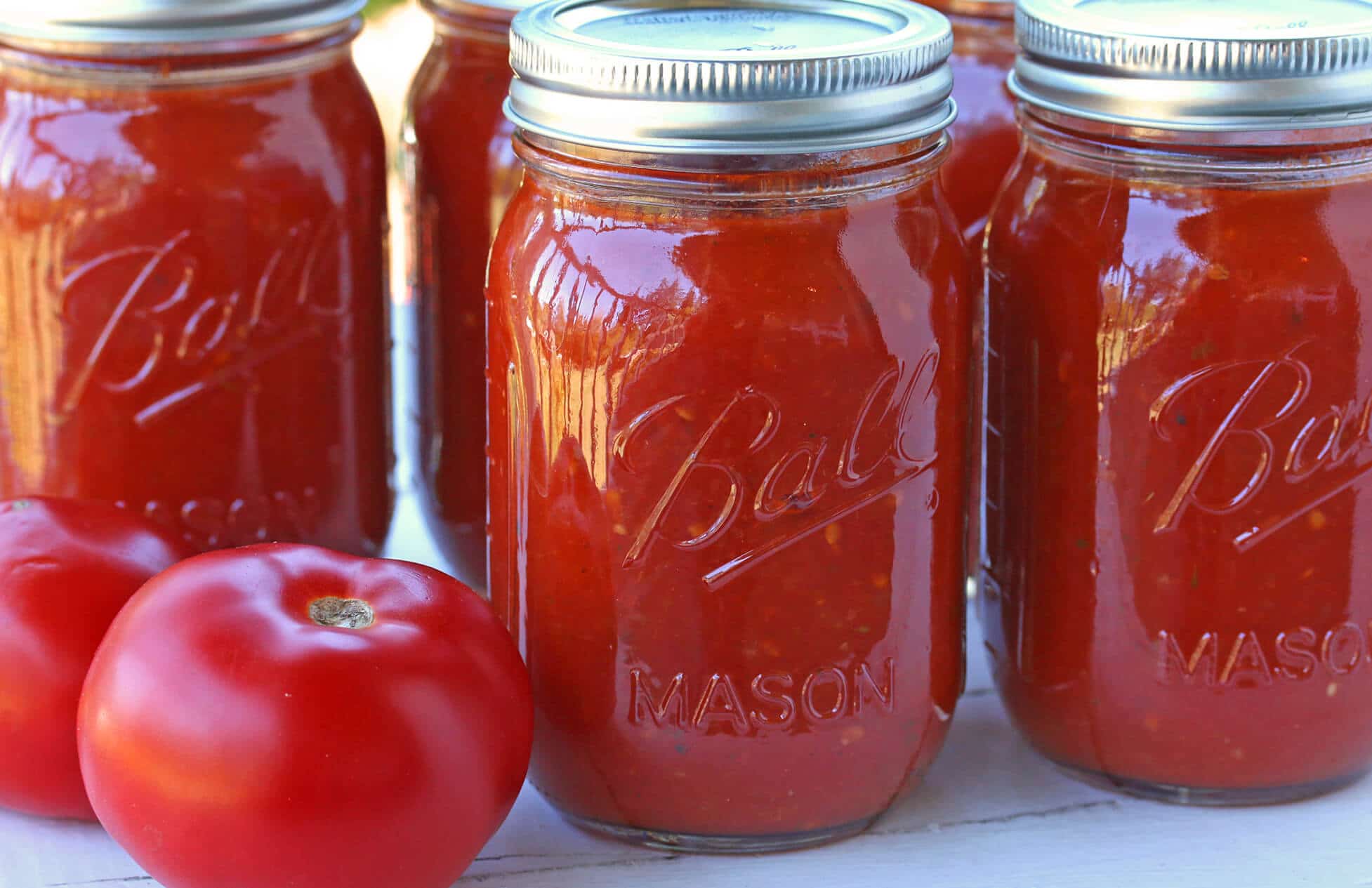
Can You Freeze Marinara Sauce?
Yes, this marinara freezes really well and there is no need to add lemon juice or citric acid. Put the cooled marinara sauce in freezer ziplock bags and lay them flat to take up less space or freeze the sauce in containers. It will keep for up to 6 months. Simply thaw and reheat on the stovetop or in the microwave.
Marinara Sauce Recipe
Select the best tomatoes you can find. The ideal tomatoes are ones that are very meaty with few seeds. Roma tomatoes fall into that category and are the most readily available and they, like other paste tomatoes like San Marzano’s, develop the best flavor when cooked down into a sauce. That said, you can use whatever tomatoes you have available and if they’re grown in your own garden so much the better.
Blanch the tomatoes for a minute in boiling water to loosen the skins. Peel the tomatoes and squeeze out and discard the seeds. Chop the tomatoes.
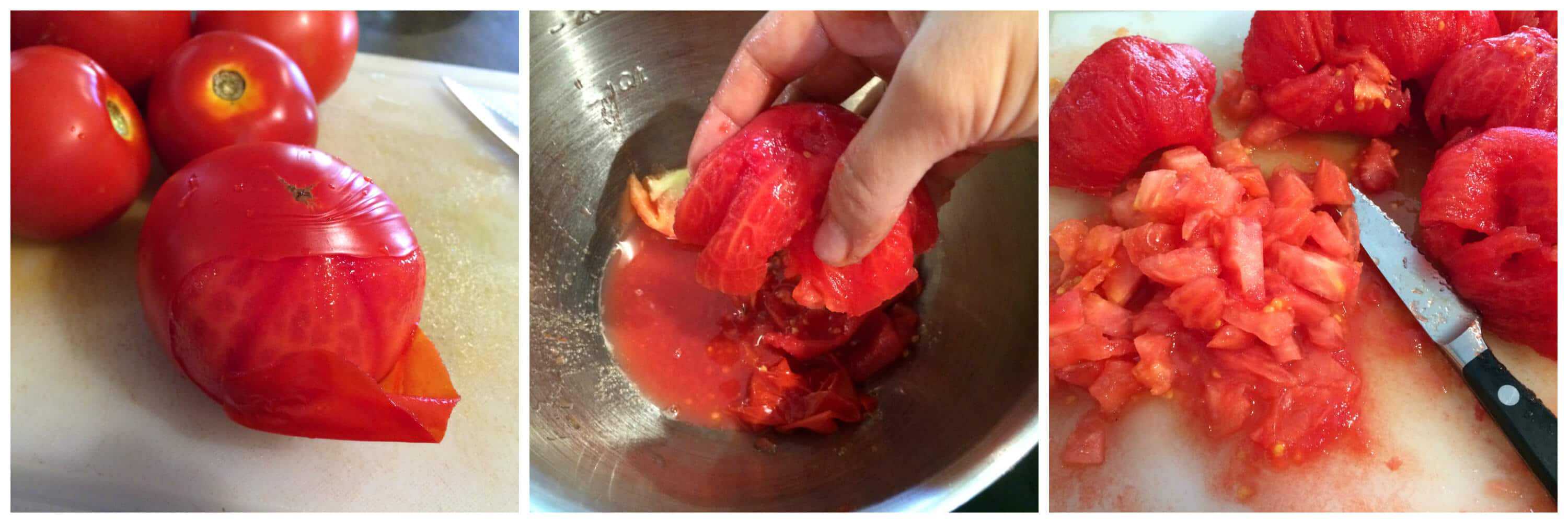
Place the tomatoes in a large pot with all the ingredients (except for the citric acid/lemon juice). Bring it to a boil, reduce the heat to low and simmer, uncovered, for 2 hours, stirring every once in a while. Adjust seasonings to taste. Discard the bay leaves.

Use an immersion blender or transfer to a blender and puree until desired consistency.
I use and recommend Cuisinart’s Immersion Blender, I’ve been using mine for 10 years and it’s still going strong.
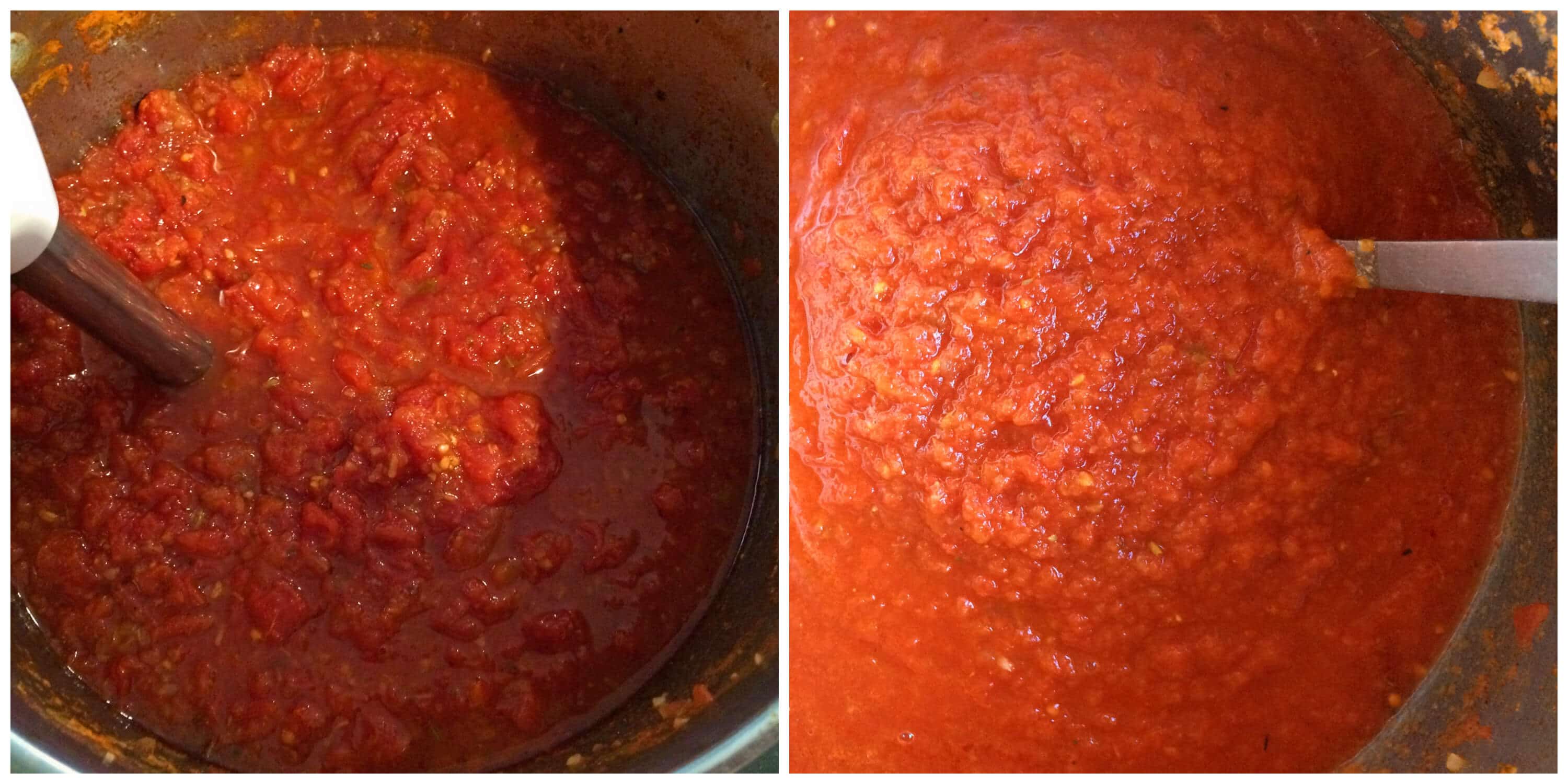
The sauce is ready but the flavor is even better after a day or two.
You can either enjoy the sauce now, freeze it, or can it for future use.

How to Can Marinara Sauce
Before you fill the sterilized jars with the marinara sauce, add 1/4 tsp Citric Acid per pint or add 1 tbsp bottled lemon juice per pint (double those quantities for quarts). This is per USDA guidelines as a requirement for safe canning. Fill the hot marinara sauce into the jars leaving 1/2 inch headspace. Wipe the rims of the jars with a damp cloth. Screw on the clean lids and rims.
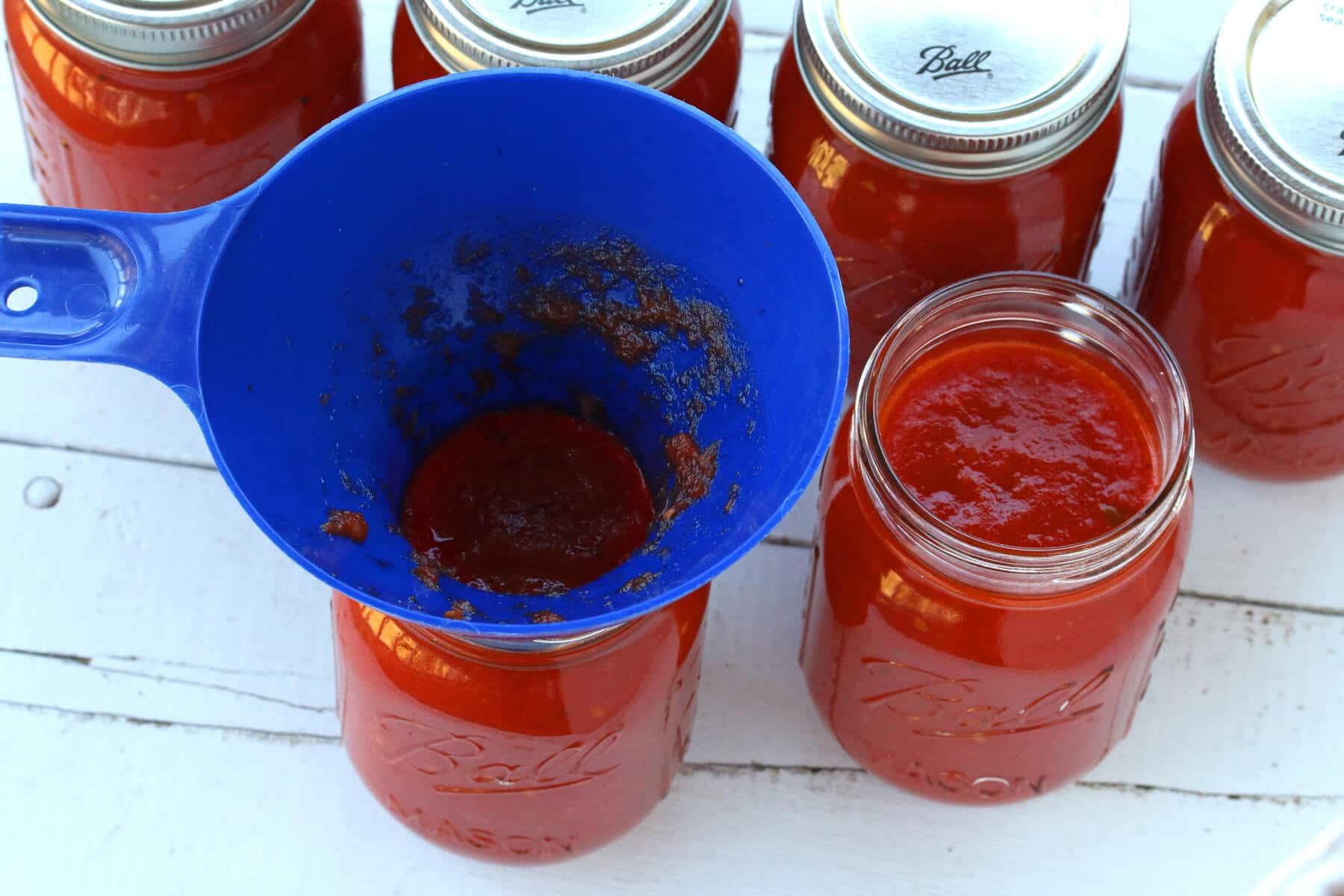
Next you’ll use a water canner to process the jars. This complete canning set has everything you’ll need. Place the jars in the boiling water canning and process for 35 minutes for pints and 40 minutes for quarts (wait for the water to return to a boil before you start the time). Turn off the heat and let the jars rest for 5 minutes before removing.
Adjustments for canning at high altitude:
- At 1,001 to 3,000 feet (305 to 914 meters) above sea level: increase processing time by 5 minutes.
- At 3,001 to 6,000 feet (914 to 1,829 meters) above sea level: increase processing time by 10 minutes.
- Above 6,000 feet (1,829 meters) increase processing time by 15 minutes.
Carefully remove the jars from the water canner and let them sit undisturbed for 24 hours. Check the seals. Stored in a dark, cool place the jars will keep for at least a year but for best flavor use within six months.

Enjoy!

For more fabulous canning recipes be sure to try our:
- Pickled Pepperoncini Peppers
- Pickled Jalapenos
- Pickled Okra
- Dill Pickle Relish
- Giardiniera
- Corn Relish
- Bread and Butter Pickles
- Sweet Pepper and Onion Relish
- Pickled Onions
- Pickled Carrots
- Pickled Banana Peppers
- Pickled Green Beans
- Pickled Asparagus
- Pickled Beets
Save This Recipe
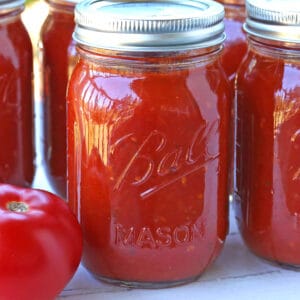
BEST Marinara Sauce
Ingredients
- 12 pounds ripe tomatoes
- 1/2 cup dried/dehydrated minced onion (provides a great flavor boost and is especially suited to canning for long-term storage)
- 6 cloves garlic, minced
- 1/4 cup extra virgin olive oil * omit if canning (see note)
- 3 tablespoons brown sugar
- 2 tablespoons sea salt
- 1 tablespoon dark balsamic vinegar
- 1 1/2 teaspoons dried rosemary
- 1 1/2 teaspoons dried oregano
- 1 1/2 teaspoons dried basil
- 1 1/2 teaspoons dried thyme
- 1 teaspoon crushed fennel seeds
- 1/2 teaspoon dried ground sage
- 1/2 teaspoon freshly ground black pepper
- 2 bay leaves
- citric acid or bottled lemon juice, if canning (per USDA guidelines as a requirement for safe canning)
Instructions
- Blanch the tomatoes for about a minute in a pot of boiling water to loosen the skins. Peel the tomatoes, squeeze out and discard the seeds. Chop the tomatoes.
- Place the chopped tomatoes in a large pot along with the remaining ingredients (except for the citric acid). Bring to a boil, reduce the heat to low and simmer, uncovered for 2 hours, stirring every now and then. Discard the bay leaves. Adjust the salt and pepper to taste. Use an immersion blender or transfer to a blender to puree until desired consistency is reached.You can use the sauce now (flavor gets better in a day or two), freeze it or can it for long-term storage.
- To can the sauce: Place 1/4 teaspoon citric acid or 1 tablespoon bottled lemon juice in the bottom of each sterilized pint-sized jar (double the quantity for quart jars). Ladle the hot marinara sauce into the jars, leaving 1/2 inch headspace. Wipe the rims clean with a damp cloth. Screw on the clean lids and rims. Place the jars in a boiling water canner and process 35 minutes for pints and 40 minutes for quarts. Turn off the heat and let the jars sit for 5 minutes. Remove the jars and let sit undisturbed for 24 hours. Check the seals. Stored in a dark, cool place the jars will keep for at least a year but for best flavor use within six months.Makes approximately 6 pints.
Notes
- At 1,001 to 3,000 feet (305 to 914 meters) above sea level: increase processing time by 5 minutes.
- At 3,001 to 6,000 feet (914 to 1,829 meters) above sea level: increase processing time by 10 minutes.
- Above 6,000 feet (1,829 meters) increase processing time by 15 minutes.
Nutrition
Originally published on The Daring Gourmet September 8, 2017



















Hello! Is the 12 lbs of tomatoes in the ingredient list before or after you prep them? I had about 30 lbs and now prepped them.
Thanks
Hi Gretchen, it’s 12 lbs of whole tomatoes, before prepping. Just double+ up on the other ingredients and your sauce will be perfect.
If I were to add garlic would you recommend fresh or powder? And if fresh how many cloves? Or Is it better to add to it once I’m ready to eat? Would adding red pepper flakes affect the safety of it? Should I close to triple up on the spices since I have 30 lbs? Next to your double I assume that is what you meant by the plus sign. Thanks so much for your quick response!
I would probably aim for one garlic clove per 2 pounds of tomatoes, so about 15 cloves. Red pepper flakes are perfectly fine to add. Yes, I would nearly triple everything. Give the sauce a taste at the end of cooking it and see if you want to add more, keeping in mind that the flavors will intensify after the sauce has sat for a while. Happy canning! :)
I didn’t add the rosemary because I’m not a fan. I did add 6 cloves of garlic and 1 can of tomato paste for colour.
awesome recipe. i will make this again.
That’s awesome, Tracy, thank you!
I finally got all my tomatoes peeled and seeded, although I see a some seeds in the sauce as it’s simmering. Also I collected all the juices that escaped while peeling and seeding and poured it back in with the chopped tomatoes – hope that’s ok. Do the seeds affect the canning process? If you were to include garlic, when would you include it in the marinara – at the time of consumption as you were reheating the sauce or at some point while the marinara is simmering? Since I don’t have my canning equipment right now is it safe to can when the equipment arrives in a few days? Maybe I should just freeze it this time and do canning when I’m totally ready. I’m new at making my marinara sauce from scratch. Usually I make it using canned tomatoes. I can’t wait to see how this turns out. The kitchen already smells heavenly. Great instructions by the way.
Hi Daniel, no, the seeds don’t affect the canning process, they’re perfectly fine. I would just add the garlic in with everything else when you simmer the sauce. You can definitely freeze the marinara if you like. The important thing with canning is that the sauce needs to be ladled into the sterilized jars while it’s hot – simmering the sauce kills any bacteria. So if you’re going to keep the sauce for a couple of days and then can it, be sure to bring the sauce back to a boil and then can it. I’m glad it smells good and hope you’re equally happy with the flavor!
It’s 1245 here in Texas and I am just starting the canning process…I let the sauce cook a bit longer due to the sheer amount. It is yummy and I can only imagine how it will taste in a few weeks when it has time to “settle’. Thank you again and please know if it weren’t for selfless people like you myself and many others would only dream of canning and cooking in our kitchen…your the best! O and that sauce is pretty darn good too!
Thank you so much and I’m so glad you enjoyed the sauce!
I tripled your recipie…..36 pounds of Roma tomatoes!! WOW MY HANDS ARE TIRED. Just came to a boil on the stove so now I start my 2 hour simmer. I am excited to can this and have a question for you…why is there no garlic in your recipie and if it will work how much would you suggest adding? Thank you for the recipie.
WOW, Michael!! That’s awesome that you’re going to have that much homemade marinara to enjoy throughout the year. The garlic – that’s just personal preference, the flavor of it tends to alter over the course of long-term storage. You can certainly add some if you like. I’d probably aim for 1 clove of garlic for every 2 pounds of tomatoes, so about 18 cloves of garlic or a little less for your 36 pounds of tomatoes. Happy canning and I hope you enjoy the fruits of your labor!
I have never heard of dried/dehydrated minced onion. Where do you find it? Or how do you dehydrate it without any special equipment? I only found onion granules in the bulk spice section of the organic store. Is it the same thing as dehydrated onion? Would the same amount apply to this form factor.
Second question is about fennel. Do you mean fennel seeds or fresh? Is it the same as anise?
Thank you
Hi Nat, yes, onion granules are the same thing and yes, this refers to fennel seeds, not fresh. If you have a hard time finding the fennel seeds or don’t have any other use for them, you can omit them. I like the flavor profile they add but it will also taste good without them. Happy canning!
Thank you so much Kimberly for a super fast response! I was literally just beginning to use your recipe to prep my freshly picked Ace tomatoes! Also, have you had any experience with Ace tomatoes (a hairloom variety, which is extremely flavorful, juicy, but low acidity)?
Also, I dont have a citric acid, but have plenty of lemons. Can those be used instead and if so, in what amount?
You’re welcome! I’m not familiar with Ace tomatoes but they sound fantastic. Yes, you can use lemon juice instead of citric acid but it needs to be store-bought bottled lemon juice, the reason being that the pH of fresh lemon juice fluctuates and consistency is important for safe canning. You would add 1 tablespoon in the bottom of each pint-sized jar, or 2 tablespoons per quart-sized jar.
I just finished the sauce, following the exact recipe (well, except the lemon juice. I used freshly squeezed instead), and it turned out absolutely DELICIOUS! The flavors are rich and very well balanced. Fennel seeds was a really nice touch. Thank you so much for sharing this wonderful recipe! Will use it again for sure, now on a larger batch of tomatoes :)
I’m absolutely thrilled to hear that, thanks so much for the feedback!
I did some research to be sure and your amount of citric acid to be added for canning is twice what is recommended. Everything I found says 1/4 tsp per pint and 1/2 for quarts.
Thanks, Michael.
I hope this isn’t a repeat of an earlier post I made. I thought I submitted, but now don’t see my comment. So, My question is, do you have a cup amount for the tomatoes? I have used a ‘sqeezo’ and what I have is a sauce, like what is sold in a can. I have made one batch and it was wonderful. Ready to do another batch or two! I hope this made some sort of sense to you:-)
Hi Jan, I’m sorry I haven’t measured it by the cup. Perhaps one of our readers has and can chime in…